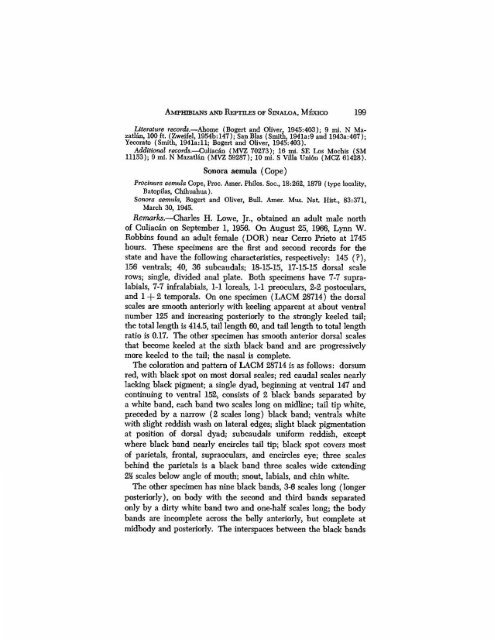The Amphibians and Reptiles of Sinaloa, Mexico - Smithsonian ...
The Amphibians and Reptiles of Sinaloa, Mexico - Smithsonian ...
The Amphibians and Reptiles of Sinaloa, Mexico - Smithsonian ...
You also want an ePaper? Increase the reach of your titles
YUMPU automatically turns print PDFs into web optimized ePapers that Google loves.
AMPHIBIANS AND REPTILES OF SINALOA, Mixioo 199<br />
Literature records.—Ahome {Bogert <strong>and</strong> Oliver, 1945:403); 9 mi. N Mazadao,<br />
100 ft. {Zweifel, 1954b:I47); San Bias (Smith, 1941a:9 <strong>and</strong> 1943a:467);<br />
Yeoorato (Smith, 1941a:ll; Bogert <strong>and</strong> Oliver, 1945:403).<br />
Additional records.—Culiacan (MVZ 70273); 16 mi. SE Los Mochis (SM<br />
11153); 9 mi. N Mazatlan (MVZ 59287); 10 mi. S Villa Union (MCZ 61428).<br />
Sonora aemula (Cope)<br />
Procinura aemula Cope, Proc. Amer. Philos. Soc, 18:262, 1879 (type locality,<br />
Batopilas, Chihuahua).<br />
Sonora aemula, Bogert <strong>and</strong> Oliver, Bull. Amer. Mus, Nat. Hist., 83:371,<br />
March 30, 1945.<br />
Remarks.—Charles H. Lowe, Jr., obtained an adult male north<br />
<strong>of</strong> Culiacan on September 1, 1956. On August 25, 1966, Lynn W.<br />
Robbins found an adult female (DOR) near Cerro Prieto at 1745<br />
hours. <strong>The</strong>se specimens are the first <strong>and</strong> second records for the<br />
state <strong>and</strong> have the following characteristics, respectively: 145 (?),<br />
156 ventrals; 40, 36 subcaudals; 18-15-15, 17-15-15 dorsal scale<br />
rows; single, divided anal plate. Roth specimens have 7-7 supra*<br />
labials, 7-7 infralabials, 1-1 loreals, 1-1 preoculars, 2-2 postoculars,<br />
<strong>and</strong> 1 + 2 temporals. On one specimen (LACM 28714) the dorsal<br />
scales are smooth anteriorly with keeling apparent at about ventral<br />
number 125 <strong>and</strong> increasing posteriorly to the strongly keeled tail;<br />
the total length is 414.5, tail length 60, <strong>and</strong> tail length to total length<br />
ratio is 0.17. <strong>The</strong> other specimen has smooth anterior dorsal scales<br />
that become keeled at the sixth black b<strong>and</strong> <strong>and</strong> are progressively<br />
more keeled to the tail; the nasal is complete.<br />
<strong>The</strong> coloration <strong>and</strong> pattern <strong>of</strong> LACM 28714 is as follows: dorsum<br />
red, with black spot on most dorsal scales; red caudal scales nearly<br />
lacking black pigment; a single dyad, beginning at ventral 147 <strong>and</strong><br />
continuing to ventral 152, consists <strong>of</strong> 2 black b<strong>and</strong>s separated by<br />
a white b<strong>and</strong>, each b<strong>and</strong> two scales long on midline; tail tip white,<br />
preceded by a narrow (2 scales long) black b<strong>and</strong>; ventrals white<br />
with slight reddish wash on lateral edges; slight black pigmentation<br />
at position <strong>of</strong> dorsal dyad; subcaudals uniform reddish, except<br />
where black b<strong>and</strong> nearly encircles tail tip; black spot covers most<br />
<strong>of</strong> parietals, frontal, supraoculars, <strong>and</strong> encircles eye; three scales<br />
behind the parietals is a black b<strong>and</strong> three scales wide extending<br />
2JB scales below angle <strong>of</strong> mouth; snout, labials, <strong>and</strong> chin white.<br />
<strong>The</strong> other specimen has nine black b<strong>and</strong>s, 3-6 scales long (longer<br />
posteriorly), on body with the second <strong>and</strong> third b<strong>and</strong>s separated<br />
only by a dirty white b<strong>and</strong> two <strong>and</strong> one-half scales long; the body<br />
b<strong>and</strong>s are incomplete across the belly anteriorly, but complete at<br />
midbody <strong>and</strong> posteriorly. <strong>The</strong> interspaces between the black b<strong>and</strong>s
















